
|
|

May 4, 2007
The Big Trip 2006, Part XIII: Seattle's West Tiger and Cougar Mountains
Once every year or so, when finances and schedules permit, your editor and a couple of his similarly-obsessed radio pals get together to spend a week or so exploring a corner of our great nation, packing our schedules as full as possible to visit as many interesting broadcast facilities as we can.
And then, a few months later, once we've caught our breath (and some much-needed sleep), we share it all with you here on Tower Site of the Week (and in audio form over on Tophour.com) in a feature we call "The Big Trip."
The 2006 version of the Big Trip began and ended in Seattle, and along the way took us as far south as Eugene, Oregon and as far east as Coeur d'Alene, Idaho.
Day Nine - Friday, September 29
More than a week after we all touched down in Seattle, we're back in the Emerald City to spend a couple of days seeing its broadcast sites before heading home, and like most coastal days so far on the trip, this Friday morning dawns with a bit of fog that quickly burns off to a spectacular blue sky, shattering every stereotype about Seattle weather that there is.

Our first destination this morning takes us as far east as the Seattle market goes. 25 miles east of downtown Seattle along I-90, not far from North Bend, Washington, Highway 18 winds its way south and east to the base of West Tiger Mountain, nearly 3000 feet above sea level, with a clear line of sight straight down to the city below.
Our host this day is Entercom senior engineer Clay Freinwald, a good friend and frequent visitor to our western New York home base in his role overseeing engineering at the company's stations in Rochester and Buffalo. He's the right tour guide for West Tiger Mountain, because he's the guy who brought high-power broadcast to this site in the late 1980s, when he began developing the first site here (the tower on the left in the panorama above, shot from the east and looking southwest to northeast) for KBSG (97.3 Tacoma), which moved up here from Tacoma in 1987.
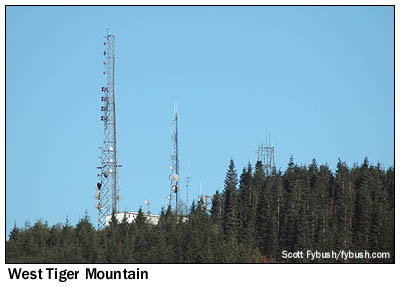
|
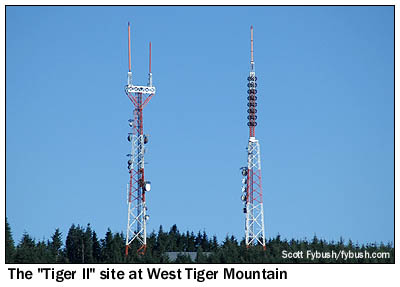
|
At the time, many engineers in town thought West Tiger was a risky bet. FM and TV in the Seattle market, as we'll see later on, had traditionally been located on lower hilltops scattered around Seattle, Tacoma and the Puget Sound region, putting lots of signal strength over the urban areas from fairly short antenna heights. West Tiger, by contrast, was so far above average terrain (2391', for KBSG) that it required class C stations to be derated from the full 100 kW class maximum - 52 kW for KBSG, 57-67 kW for the stations that came along later.
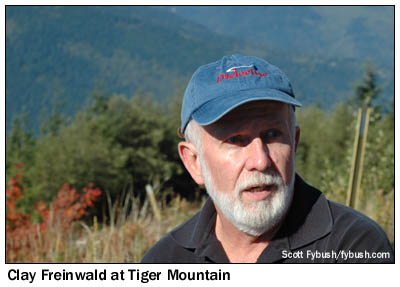
|
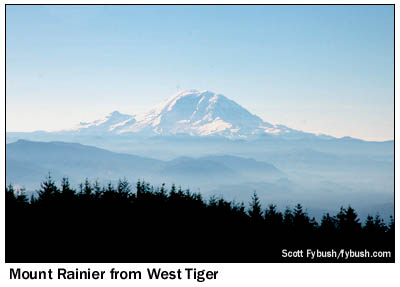
|
But in FM and TV, line of sight makes up for a lot of other problems, and so it did at West Tiger. Once KBSG was up and running from West Tiger, a slew of stations quickly followed.
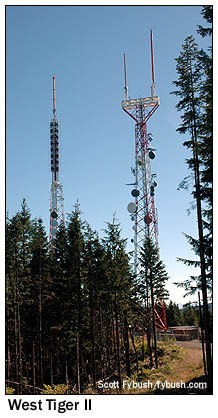 By
the time we got to KBSG's site, it had been developed into a
major master FM site, home to seven full class C signals: KBSG
(now owned by Bonneville, for reasons we'll get to eventually)
and its then-Entercom sisters KISW (99.9 Seattle), KKWF (100.7
Seattle), KMTT (103.7 Tacoma) and KNDD (107.7 Seattle), as well
as public radio KPLU (88.5 Tacoma) and classical KING-FM (98.1
Seattle), plus auxiliary facilities for KBKS (106.1 Seattle).
By
the time we got to KBSG's site, it had been developed into a
major master FM site, home to seven full class C signals: KBSG
(now owned by Bonneville, for reasons we'll get to eventually)
and its then-Entercom sisters KISW (99.9 Seattle), KKWF (100.7
Seattle), KMTT (103.7 Tacoma) and KNDD (107.7 Seattle), as well
as public radio KPLU (88.5 Tacoma) and classical KING-FM (98.1
Seattle), plus auxiliary facilities for KBKS (106.1 Seattle).
Not only did West Tiger become a major FM site, it began to be considered as a possible TV site, too. In 1998, American Tower began developing what's called "West Tiger II," a few hundred yards northeast of the Entercom site. It's now home to two major towers: the one on the left holds an 8-bay ERI master antenna that carries CBS' KMPS (94.1 Seattle), KJAQ (96.5 Seattle), KZOK (102.5 Seattle) and KBKS (106.1 Seattle), as well as Sandusky's KQMV (92.5 Bellevue) and KWJZ (98.9 Seattle). It's crowned by the antenna for what was then home-shopping KWOG and is now Fisher's Univision affiliate, KUNS (TV 51/DT 50). The TV candelabra next door holds Pax/ion's KWPX (TV 33/DT 32), Daystar's KWDK (DT42) and home-shopping (now Azteca America) outlet KHCV (TV 45/DT44).
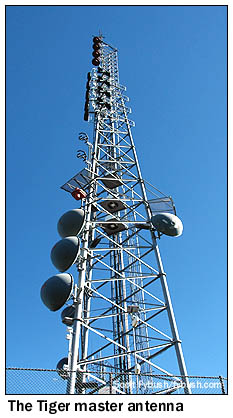 Back
at the original KBSG site, the 200-foot tower boasts a combiner
system that handles all of those stations except KBSG,
which uses the four-bay nondirectional antenna at the top of
the tower.
Back
at the original KBSG site, the 200-foot tower boasts a combiner
system that handles all of those stations except KBSG,
which uses the four-bay nondirectional antenna at the top of
the tower.
The other stations go through the combiner and into that four-bay/two-panel ERI antenna system second from the top. Yes, it's directional, but from this site, there's no significant population to the east, just miles and miles of mountains. (The two-bay ERI above the ice shield is a former aux, now used by KBSG for its HD signal, and the other one-bay just below the ice shield is a KMTT aux.)
Once we've admired the views under Clay's guidance (and there's nobody who knows more about the views from this site than Clay, who's spent the better part of two decades up here), we head inside to admire the careful thought that went into the very substantial building up here.
There are three levels to this building, and we enter at the top, where a sizable room is home to the main transmitter for KBSG and an auxiliary transmitter for KBKS.
There's a generator room next door, and a newer section of the building to the left that houses neat rows of transmitters for KNDD, KISW and KKWF, as well as an engineering bench decorated with three decades of Seattle radio logos.
Each of these transmitter installations is similar, verging on identical - a Continental 816 analog transmitter, far and away the model of choice in the Seattle market, and a BE HD transmitter.
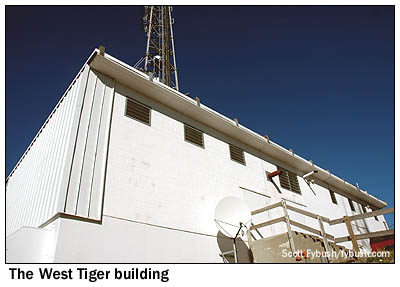
|
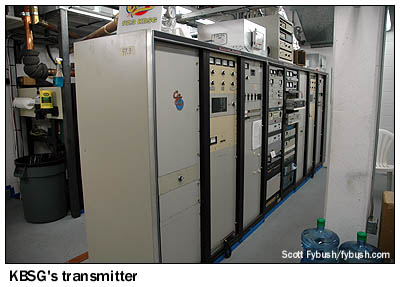
|
A spiral staircase goes down from the front room here to a half-height floor where the ERI combiner lives. Look carefully between the analog combiner modules to see where the HD signals are injected into the transmission system. The circulator and dual-feed antenna approach used here avoids the need for a separate antenna and the waste of excess RF typical of high-level-combined HD systems.
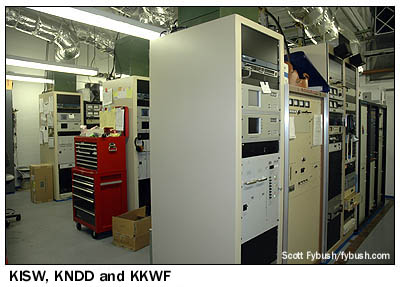
|
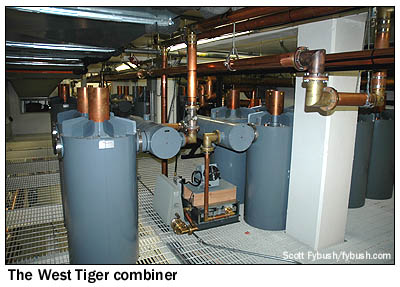
|
Down at the bottom of the stairs, we find the control panel for the combiner and rows of additional transmitters, almost all Continentals: KING-FM, KMTT and KPLU (the lone pair of BEs in the room).
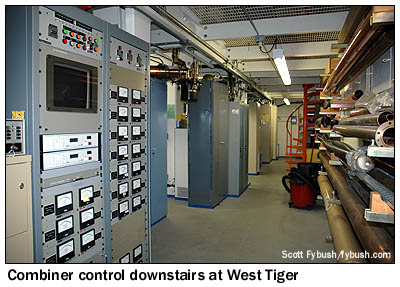
|
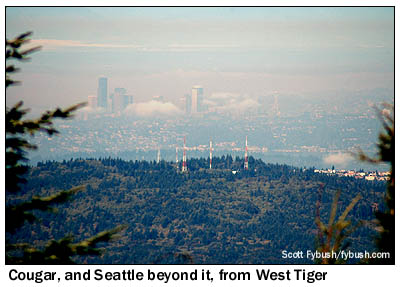
|
If this facility appears spotless in the photos, it should - Clay takes immense pride in the careful workmanship and attention to detail here, right down to an apology for a few chipped spots of paint on the concrete floor, which he notes is due for a new coat.
Returning upstairs and outside, Clay points out our next destination, Cougar Mountain, about halfway between Tiger and downtown Seattle and about halfway down (1425' above sea level) from here to Puget Sound.
After ascending West Tiger on the "old road," a rutted four-wheel-drive path that bumps a steep path up to the Entercom site, we go back down on the "new road," a (comparatively) smooth dirt road built for the American Tower construction. (It would subsequently suffer some pretty bad washouts in the storms that ripped across the Pacific Northwest a few months after our visit.)
Back down at ground level, we return to Highway 18 and then to I-90, heading west to the Seattle suburb of Issaquah and up into the mansions that now line the slopes of Cougar, right up to the gate that leads into the cluster of towers at the mountain's peak.
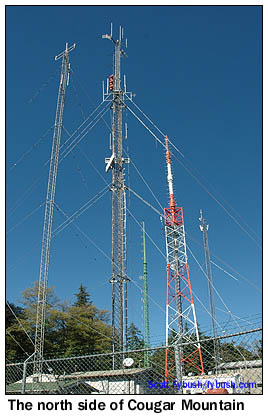
|
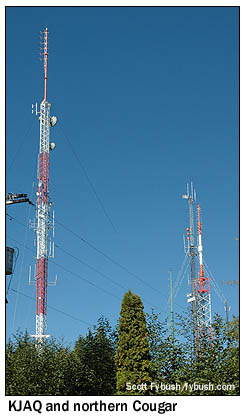
|
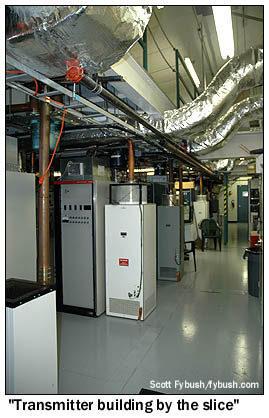
|
From a broadcast perspective, there are three major groups of towers here. The northernmost cluster ("Ratelco," named for the site owner), shown at left above, includes the green-painted tower that was the original home of Fisher's KPLZ (101.5 Seattle); the fat painted tower to the right of it, crowned by a Jampro helical master antenna that carries CBS' KUBE (93.3 Seattle), Clear Channel's KJR-FM (95.7 Seattle), KPLZ's current main, and contemporary Christian KCMS (105.3 Edmonds); and the tower in the foreground that's home to Sandusky's KRWM (106.9 Bremerton).
A short distance away, behind a separate fence, another on the mountain is the historic home of what's now KJAQ (96.5), and is still home to auxiliary transmitters for several of KJAQ's sister stations, including KMPS (94.1).
And at the southern end of the hilltop, we find one of the best-appointed auxiliary facilities in the country, Clay's other pride and joy. (All this, incidentally, in spite of some big changes in the weeks following our visit - first, Clay changed titles at Entercom, taking responsibility for the local FMs in lieu of his former national engineering duties, and then Entercom traded off its two AMs, KIRO 710 and KTTH 770, as well as KBSG, to Bonneville, separating Clay from the 97.3 for the first time in some 28 years.)
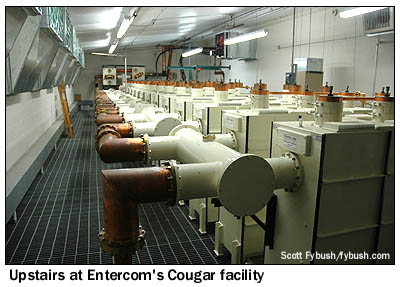
|
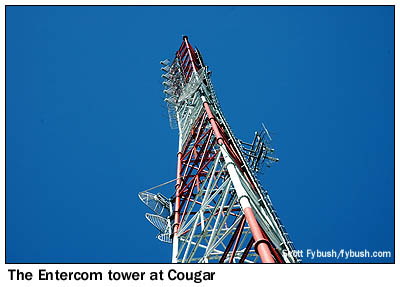
|
Clay refers to the Entercom auxiliary facility here on Cougar as "transmitter building by the slice," which is an apt way to describe what's here: a long, narrow building with row after row of transmitters on the ground floor, each one with a dummy load next to it and transmission line pointing straight up to the appropriate module of the Shively combiner up on the mezzanine.
There's one primary site here: KNHC (89.5 Seattle), the dance-music noncomm that's licensed to the Seattle schools, feeding that two-bay directional panel antenna in the lower right corner of our tower picture, above - but everything else here is purely auxiliary, feeding the combiner and then that six-bay panel antenna atop the tower: Entercom's KBSG, KISW, KKWF, KMTT and KNDD; plus KPLU, KING-FM and KZOK. This is probably the largest collection of working vintage Collins 831G transmitters in captivity, with a handful of BEs scattered into the mix, and even one Harris FM5K as a backup for KNHC.
From Cougar, we continue downhill, stopping for lunch before parting ways with Clay - temporarily, at least - and making an ill-fated attempt to visit the AM towers on Vashon Island. We'll chronicle that, and the rest of the trip, in our next and final installment of our Big Trip recap, coming to this space in a week.
(And join us over at Tophour.com on Wednesday, May 9 to hear the first installment of our Seattle legal IDs!)
 The
Tower Site Calendar 2007 is here! They're about to sell out,
just like 2006 did - order today at the Fybush.com
Store!
The
Tower Site Calendar 2007 is here! They're about to sell out,
just like 2006 did - order today at the Fybush.com
Store!
- Previous Site of the Week: Ellensville, Wenatchee and Everett, Washington
- Next Week: Seattle Studios and TV Towers, plus Mount Vernon and Whidbey Island
- Site of the Week INDEX!
- How can you help support Site of the Week? Click here!
- Submit your suggestions for a future Site of the Week!
